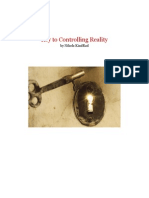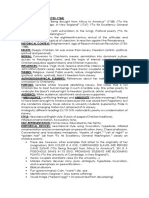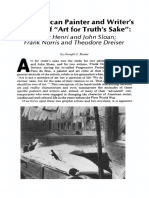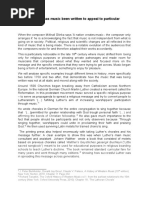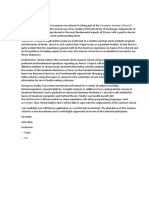0 ratings0% found this document useful (0 votes)
21 viewsRuth Crawford'S "Spiritual Concept" 223
Ruth Crawford'S "Spiritual Concept" 223
Uploaded by
awfefaThis document summarizes Ruth Crawford's spiritual views as expressed in her diary from 1927. It discusses how her commitment to Methodism waned after moving to Chicago in 1921 and being exposed to more progressive ideas. By the late 1920s, she had distanced herself from the "personal element" and "too material and literal" attitudes of evangelical Christianity. The document then quotes directly from Crawford's diary where she realizes the close relation between artistic and religious emotion. She believes art and religion both fulfill a need for humans to express something profound within themselves. The last paragraph discusses how Crawford's spiritual views were influenced by Theosophy, Eastern religions, American Transcendentalism, and Walt Whitman - drawing from a diverse
Copyright:
© All Rights Reserved
Available Formats
Download as PDF, TXT or read online from Scribd
Ruth Crawford'S "Spiritual Concept" 223
Ruth Crawford'S "Spiritual Concept" 223
Uploaded by
awfefa0 ratings0% found this document useful (0 votes)
21 views1 pageThis document summarizes Ruth Crawford's spiritual views as expressed in her diary from 1927. It discusses how her commitment to Methodism waned after moving to Chicago in 1921 and being exposed to more progressive ideas. By the late 1920s, she had distanced herself from the "personal element" and "too material and literal" attitudes of evangelical Christianity. The document then quotes directly from Crawford's diary where she realizes the close relation between artistic and religious emotion. She believes art and religion both fulfill a need for humans to express something profound within themselves. The last paragraph discusses how Crawford's spiritual views were influenced by Theosophy, Eastern religions, American Transcendentalism, and Walt Whitman - drawing from a diverse
Original Description:
wavwvawrgarwgwvawawfwssssserr
Original Title
aweacwaecwecaweaw
Copyright
© © All Rights Reserved
Available Formats
PDF, TXT or read online from Scribd
Share this document
Did you find this document useful?
Is this content inappropriate?
This document summarizes Ruth Crawford's spiritual views as expressed in her diary from 1927. It discusses how her commitment to Methodism waned after moving to Chicago in 1921 and being exposed to more progressive ideas. By the late 1920s, she had distanced herself from the "personal element" and "too material and literal" attitudes of evangelical Christianity. The document then quotes directly from Crawford's diary where she realizes the close relation between artistic and religious emotion. She believes art and religion both fulfill a need for humans to express something profound within themselves. The last paragraph discusses how Crawford's spiritual views were influenced by Theosophy, Eastern religions, American Transcendentalism, and Walt Whitman - drawing from a diverse
Copyright:
© All Rights Reserved
Available Formats
Download as PDF, TXT or read online from Scribd
Download as pdf or txt
0 ratings0% found this document useful (0 votes)
21 views1 pageRuth Crawford'S "Spiritual Concept" 223
Ruth Crawford'S "Spiritual Concept" 223
Uploaded by
awfefaThis document summarizes Ruth Crawford's spiritual views as expressed in her diary from 1927. It discusses how her commitment to Methodism waned after moving to Chicago in 1921 and being exposed to more progressive ideas. By the late 1920s, she had distanced herself from the "personal element" and "too material and literal" attitudes of evangelical Christianity. The document then quotes directly from Crawford's diary where she realizes the close relation between artistic and religious emotion. She believes art and religion both fulfill a need for humans to express something profound within themselves. The last paragraph discusses how Crawford's spiritual views were influenced by Theosophy, Eastern religions, American Transcendentalism, and Walt Whitman - drawing from a diverse
Copyright:
© All Rights Reserved
Available Formats
Download as PDF, TXT or read online from Scribd
Download as pdf or txt
You are on page 1of 1
RUTH CRAWFORD'S"SPIRITUALCONCEPT" 223
meetings.6 All of this began to change in 1921, when she moved to
Chicago, which her mother described as having "the advanced
atmosphere of the third largest city in the world."7 Not surprisingly,
her own commitment to Methodism waned and by the late 1920S she
distanced herself from the "personal element" and the "too material
and literal" attitudes she associated with evangelical Christianity.8
Unlike Charles Ives or Virgil Thomson, Crawford did not see the
church music of her youth as a musical resource: her experience with
religion had been too strict to sustain nostalgia or idealization.
Diary, 15 November 1927: Concretely since the Schlusnus concert
[Schlusnuswas a Germanbaritone],abstractlysincethe lastfew months,
duringwhich I have been unconsciouslypreparingfor the discovery,I
suddenly realize the close relation of the artistic and the religious
emotion;art and religionresult both from a need for man to express
somethingbig in himself.The religiousexpressthis up-flowing,expand-
ing, engulfing,floweringemotionby trying to createbetterconditions
aroundthem, helpingpoor and sick people, or else simply by spending
this not-containable joy that threatens to burst them in worship of a great
God. ... In the same way the composer of music releases these surging
painful joys into tones, the sculptor into marble, the painter into color
and rhythm, the poet into sweeping words. . . . Doing this, they either
exchange religion for their art, feeling no need for the former, or,
merging the two in mystic beauty, attain greater heights in ther art,
become spiritual, not simply "religious"and creators in the highest sense.
Crawford's spiritual manifesto was based on a group of ideas, not
all of equal prominence, but nevertheless interactive and supportive of
one another. Among the most important are Theosophy, Eastern
religious philosophy, nineteenth-century American Transcendental-
ism, and the imaginative tradition of Walt Whitman. Thus Crawford
was drawing on an eclectic legacy of ideas and values that had been
linked in American intellectual life since the turn of the century,9 to
6 Diaries from 1912
through 1914 as well as clippings in scrapbooks describe her
involvement with the Methodist church. These diaries are in private collections. The
author is grateful to Michael Seeger and BarbaraSeeger for access to this material.
7 Letter, Clara Crawford to Ruth Crawford, 22 May 1922. Seeger Estate.
8 Diary, [2] September1927.
9 These sources are analyzed as the core of a spiritual tradition in modern art in
the exhibition catalogue, TheSpiritualin Art: AbstractPainting 189o0-985 (New York:
Abbeville Press, 1986). This study owes a great deal to that catalogue. The most
germane essays are Maurice Tuchman, "Hidden Meanings in Abstract Art," 17-62;
Charles C. Eldredge, "Nature Symbolized: American Painting from Ryder to
Hartley," I 13-30; and Lynda Dalrymple Henderson, "Mysticism, Romanticism, and
the Fourth Dimension," 219-38. See also Gail Levin, "Marsden Hartley and
You might also like
- Case 3-1 Parable of Sadhu 3EDocument6 pagesCase 3-1 Parable of Sadhu 3ERudy50% (2)
- After the End of Art: Contemporary Art and the Pale of History - Updated EditionFrom EverandAfter the End of Art: Contemporary Art and the Pale of History - Updated EditionRating: 3.5 out of 5 stars3.5/5 (26)
- Devouring Frida: The Art History and Popular Celebrity of Frida KahloFrom EverandDevouring Frida: The Art History and Popular Celebrity of Frida KahloRating: 3 out of 5 stars3/5 (1)
- Frida Kahlo: Her Life and Art Revisited PDFDocument16 pagesFrida Kahlo: Her Life and Art Revisited PDFperdidalmaNo ratings yet
- StuffDocument409 pagesStuffAnonymous wQpdpN5J94% (18)
- Bynum - The Body of Christ in The Later Middle AgesDocument21 pagesBynum - The Body of Christ in The Later Middle AgesEthan Robey100% (1)
- Into the Mystic: The Visionary and Ecstatic Roots of 1960s Rock and RollFrom EverandInto the Mystic: The Visionary and Ecstatic Roots of 1960s Rock and RollRating: 3 out of 5 stars3/5 (5)
- Holst AstrologyDocument9 pagesHolst AstrologyCarola CostaNo ratings yet
- KeytoControllingReality v.0.93Document18 pagesKeytoControllingReality v.0.93Nikolay KindRad90% (10)
- What Is Metacognition? Author(s) : Michael E. Martinez Source: The Phi Delta Kappan, May, 2006, Vol. 87, No. 9 (May, 2006), Pp. 696-699 Published By: Phi Delta Kappa InternationalDocument5 pagesWhat Is Metacognition? Author(s) : Michael E. Martinez Source: The Phi Delta Kappan, May, 2006, Vol. 87, No. 9 (May, 2006), Pp. 696-699 Published By: Phi Delta Kappa InternationalLanguage LabNo ratings yet
- Gospelchristianity PDFDocument84 pagesGospelchristianity PDFMiguel Davilla100% (2)
- 222 Journal of The American Musicological SocietyDocument1 page222 Journal of The American Musicological SocietyawfefaNo ratings yet
- Edge of Taos Desert: An Escape to RealityFrom EverandEdge of Taos Desert: An Escape to RealityRating: 4 out of 5 stars4/5 (13)
- Hiding in The Open Religious Art After 14743-241-42662-1-10-20200823Document18 pagesHiding in The Open Religious Art After 14743-241-42662-1-10-20200823MarcosGraminhaNo ratings yet
- Rewiring the Real: In Conversation with William Gaddis, Richard Powers, Mark Danielewski, and Don DeLilloFrom EverandRewiring the Real: In Conversation with William Gaddis, Richard Powers, Mark Danielewski, and Don DeLilloRating: 3 out of 5 stars3/5 (1)
- Republic of Taste: Art, Politics, and Everyday Life in Early AmericaFrom EverandRepublic of Taste: Art, Politics, and Everyday Life in Early AmericaNo ratings yet
- Ruth Crawford'S "Spiritual Concept" 225Document1 pageRuth Crawford'S "Spiritual Concept" 225awfefaNo ratings yet
- A New Hedonism in Oscar Wilde'S Novel The: Picture of Dorian GrayDocument4 pagesA New Hedonism in Oscar Wilde'S Novel The: Picture of Dorian GrayАня КогутNo ratings yet
- Communication, Dissenters and Popular Culture in Eighteenth Century EuropeDocument10 pagesCommunication, Dissenters and Popular Culture in Eighteenth Century EuropeLata DeshmukhNo ratings yet
- 11 - Chapter 4 PDFDocument17 pages11 - Chapter 4 PDFpriyashree jaiswalNo ratings yet
- Art in The 1960sDocument20 pagesArt in The 1960scara_fiore2100% (2)
- Occult Roots of The Russian Revolution PDFDocument19 pagesOccult Roots of The Russian Revolution PDFNadina Pana100% (1)
- Boyd RiceDocument6 pagesBoyd RiceCorneliu MeciuNo ratings yet
- PHILLIS WHEATLEY ApuntesDocument13 pagesPHILLIS WHEATLEY ApuntesAroa Gomez Garciia100% (1)
- Twentieth Century and ModernismDocument24 pagesTwentieth Century and Modernismφελίσβερτα ΩNo ratings yet
- History of English Assignment 1st PDFDocument22 pagesHistory of English Assignment 1st PDFHassan JavedNo ratings yet
- The Arts and the Christian Imagination: Essays on Art, Literature, and AestheticsFrom EverandThe Arts and the Christian Imagination: Essays on Art, Literature, and AestheticsNo ratings yet
- Rothko Chapel The Re-Spiritualizing of MDocument20 pagesRothko Chapel The Re-Spiritualizing of MSalman TanvirNo ratings yet
- Breaking Ground: Art Modernisms 1920-1950, Collected Writings Vol. 1From EverandBreaking Ground: Art Modernisms 1920-1950, Collected Writings Vol. 1No ratings yet
- 02 Spiritualism - in - ContextDocument21 pages02 Spiritualism - in - ContextExalumnos Instituto AlonsodeErcilla100% (1)
- Anne Bradstreet TeoríaDocument5 pagesAnne Bradstreet TeoríaPaula Mena ArribasNo ratings yet
- AwecawecDocument1 pageAwecawecawfefaNo ratings yet
- The Pre-Raphaelite Journey Into The Middle AgesDocument15 pagesThe Pre-Raphaelite Journey Into The Middle Agesjoyce.voeglerNo ratings yet
- Occult Roots of The Russian RevolutionDocument10 pagesOccult Roots of The Russian RevolutionCarlosAmadorFonsecaNo ratings yet
- Devils Pleasure Palace Media Kit PDFDocument8 pagesDevils Pleasure Palace Media Kit PDFLucas TisseraNo ratings yet
- 5Document5 pages5Huszár ViktóriaNo ratings yet
- Gebauer, Dianne - Queercore - Subcultural Tensions, Resistance, and Identity Politics in 1900s LondonDocument64 pagesGebauer, Dianne - Queercore - Subcultural Tensions, Resistance, and Identity Politics in 1900s LondonJoshua CurtisNo ratings yet
- Art For Truth SakeDocument16 pagesArt For Truth Sakehasnat basir100% (1)
- Sanders - U3 Late Victorian and Edwardian LiteratureDocument12 pagesSanders - U3 Late Victorian and Edwardian LiteratureMelanie HadzegaNo ratings yet
- Christianity and The Visual ArtsDocument36 pagesChristianity and The Visual Artsarnab SarkarNo ratings yet
- Sears 1889 A Collection of Works Illustrative of The Dance of DeathDocument80 pagesSears 1889 A Collection of Works Illustrative of The Dance of DeathMatías AllendeNo ratings yet
- Assignment On Modernism by DaniyalDocument3 pagesAssignment On Modernism by DaniyalDaniyal AnsariNo ratings yet
- The Form Is The Message Bob Dylan and The 1960sDocument20 pagesThe Form Is The Message Bob Dylan and The 1960sishitaindia2062No ratings yet
- Spencer BlackChurchHarlem 2017Document9 pagesSpencer BlackChurchHarlem 20172wgvwrytzjNo ratings yet
- Anne Bradstreet, Phillis Wheatley and The Literary Sphere of Early AmericaDocument24 pagesAnne Bradstreet, Phillis Wheatley and The Literary Sphere of Early AmericaPatrizia Lbt Cm100% (1)
- Mabel Dodge Luhan: New Woman, New WorldsFrom EverandMabel Dodge Luhan: New Woman, New WorldsRating: 3.5 out of 5 stars3.5/5 (3)
- Heathenism Lecture NotesDocument33 pagesHeathenism Lecture NotesphilipmartysonNo ratings yet
- La Llorona's Children: Religion, Life, and Death in the U.S.–Mexican BorderlandsFrom EverandLa Llorona's Children: Religion, Life, and Death in the U.S.–Mexican BorderlandsRating: 5 out of 5 stars5/5 (1)
- We Are Made of Stories: Self-Taught Artists in the Robson Family CollectionFrom EverandWe Are Made of Stories: Self-Taught Artists in the Robson Family CollectionNo ratings yet
- Draft 9 For Public PDFDocument35 pagesDraft 9 For Public PDFspiltteethNo ratings yet
- The Great Divo EceDocument31 pagesThe Great Divo Eceramdinbrandon11No ratings yet
- Wallace Stevens EssayPoemDocument25 pagesWallace Stevens EssayPoemEmmanuel SimonNo ratings yet
- Rubinoff, Kailan R. - The Grand Guru of Baroque Music' - Leonhardt's Antiquarianism in The Progressivist 1960s PDFDocument22 pagesRubinoff, Kailan R. - The Grand Guru of Baroque Music' - Leonhardt's Antiquarianism in The Progressivist 1960s PDFCarlos Montes de Oca GuerreroNo ratings yet
- Gates of EdenDocument333 pagesGates of EdenAlanon202100% (1)
- British Pre-Raphaelites and The Question of ReincarnationDocument10 pagesBritish Pre-Raphaelites and The Question of Reincarnationbde_gnasNo ratings yet
- We Are All Cannibals: And Other EssaysFrom EverandWe Are All Cannibals: And Other EssaysRating: 5 out of 5 stars5/5 (1)
- (Christopher Dawson) Medieval Essays (B-Ok - Xyz) PDFDocument260 pages(Christopher Dawson) Medieval Essays (B-Ok - Xyz) PDFJD MANOELNo ratings yet
- ESSAY - Music HistoryDocument3 pagesESSAY - Music HistorymayyNo ratings yet
- Difference Between Classicism & RomanticismDocument3 pagesDifference Between Classicism & RomanticismShaZia Khan100% (2)
- Charisma and Counterculture - Allen Ginsberg As A Prophet For A New Generation PDFDocument16 pagesCharisma and Counterculture - Allen Ginsberg As A Prophet For A New Generation PDFLuca NigroNo ratings yet
- A Collection of Works Illustrative of The Dance of Death La Danse Macabre, Imagines Mortes, Icones Mortes, Les Images de La Mort PDFDocument80 pagesA Collection of Works Illustrative of The Dance of Death La Danse Macabre, Imagines Mortes, Icones Mortes, Les Images de La Mort PDFLeonardoBentodeAndradeNo ratings yet
- Tracing The Absent Hilma Af Klints MystiDocument11 pagesTracing The Absent Hilma Af Klints MystiJáchym KroheNo ratings yet
- AcweafwcDocument1 pageAcweafwcawfefaNo ratings yet
- AecDocument1 pageAecawfefaNo ratings yet
- Le Maître Des MaîtresDocument1 pageLe Maître Des MaîtresawfefaNo ratings yet
- Where Did Spectral Music Come From ?Document1 pageWhere Did Spectral Music Come From ?awfefaNo ratings yet
- The Tones Actually SoundingDocument1 pageThe Tones Actually SoundingawfefaNo ratings yet
- Aspects of Motion in Elliott Carter's Second String QuartetDocument34 pagesAspects of Motion in Elliott Carter's Second String Quartetawfefa100% (1)
- Ethics (Activity 3)Document4 pagesEthics (Activity 3)Dianne CopinoNo ratings yet
- Jose Maria College College of Teacher Education: Prof Ed 2-The Teaching Profession PhilosophyDocument9 pagesJose Maria College College of Teacher Education: Prof Ed 2-The Teaching Profession PhilosophyAllan Arancel Magsipoc100% (1)
- Leadership StylesDocument1 pageLeadership Stylesapi-212877977No ratings yet
- Interview With John Michael Greer by The Wiccan Pagan Times - 2004Document10 pagesInterview With John Michael Greer by The Wiccan Pagan Times - 2004liboaninoNo ratings yet
- Golden Words of Swami VivekanandaDocument134 pagesGolden Words of Swami VivekanandaAnjana CpNo ratings yet
- Jodo Shinshu Buddhist TeachingsDocument196 pagesJodo Shinshu Buddhist TeachingsJōshō Adrian Cirlea100% (2)
- Notes-1 JESONDocument8 pagesNotes-1 JESONEddie AbrenicaNo ratings yet
- 1 - CreationDocument5 pages1 - CreationAnonymous Qa4hsIwrgm100% (1)
- 3RD Quarter ReviewerDocument19 pages3RD Quarter ReviewerJelhianne Kyn MarceloNo ratings yet
- Chapter II Whats English Literature1Document9 pagesChapter II Whats English Literature1Rahmat Nakashima TomohisaNo ratings yet
- All My SonsDocument2 pagesAll My Sonssingingman100% (1)
- Critical Thinking Chapter 5-6 PDFDocument72 pagesCritical Thinking Chapter 5-6 PDFDesny LêNo ratings yet
- Theory of Knowledge AOKsDocument15 pagesTheory of Knowledge AOKsRaynaahNo ratings yet
- Logic and Critical Thinking, March To AprilDocument28 pagesLogic and Critical Thinking, March To AprilSarah Elizabeth LunasNo ratings yet
- Motivation LetterDocument6 pagesMotivation LetterYazgeldiNo ratings yet
- Interview With Philip KitcherDocument11 pagesInterview With Philip Kitcherartosk8100% (1)
- The Platonic Art of Philosophy Ed. by G PDFDocument5 pagesThe Platonic Art of Philosophy Ed. by G PDFhenaretaNo ratings yet
- The Social Scientist As Author: Clifford Geertz On Ethnography and Social ConstructionDocument24 pagesThe Social Scientist As Author: Clifford Geertz On Ethnography and Social ConstructionkinoglazNo ratings yet
- Philosophie of The UnconsciousnessDocument12 pagesPhilosophie of The Unconsciousnessnallia25No ratings yet
- 01 Enlightenment Choice Board Questions EllieDocument4 pages01 Enlightenment Choice Board Questions Elliehyeonagim421No ratings yet
- Grafiti, An - Exploration - of - Graffiti - On - Universitys - Walls - A PDFDocument14 pagesGrafiti, An - Exploration - of - Graffiti - On - Universitys - Walls - A PDFOsman OmerovicNo ratings yet
- The Dichotomy of Science and ReligionDocument4 pagesThe Dichotomy of Science and Religionalain jove rosalesNo ratings yet
- Empowering Private Tutoring by Chaining Large Language ModelsDocument11 pagesEmpowering Private Tutoring by Chaining Large Language Modelspekooo606No ratings yet
- WATSON SampleDocument13 pagesWATSON Samplesorabh71100% (1)
- Creating Worlds: A Career in Game Design: Questions 34-44 Are Based On The Following PassageDocument3 pagesCreating Worlds: A Career in Game Design: Questions 34-44 Are Based On The Following PassageJackson WellingtonNo ratings yet









